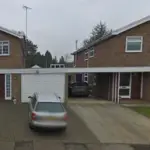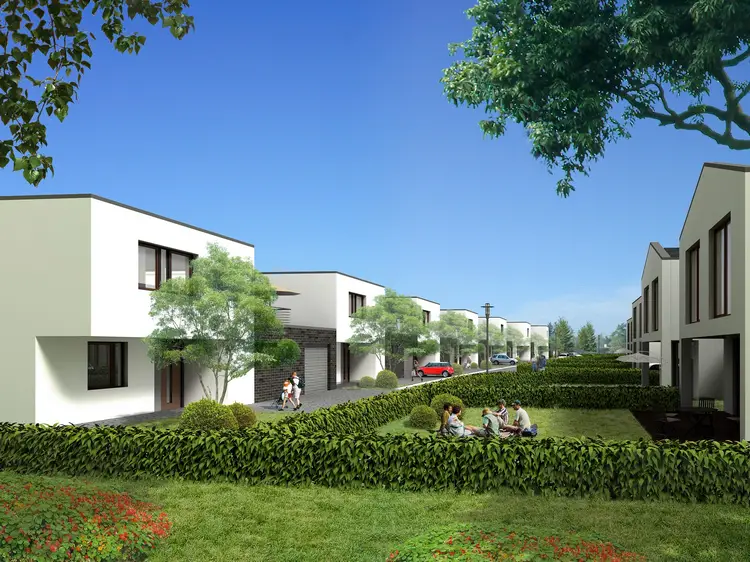
You have come across the term “Cluster House” and you’re not too sure what the term means?
This means you are probably asking questions like; what makes it a cluster house vs why is it not simply a terraced house, a semi-detached house or a flat or maisonette?
There are two important aspects of a property that makes it a cluster home, which are what makes it important you understand what a cluster house is.
A cluster house is a building of four or more individual properties where each property shares two or more party walls with one of the other properties in the block. Cluster houses are freehold properties, which means the owner of property owns it outright including the land it’s built on.
Please also take time to read this article to discover how you could save over £70,000 on your next mortgage if you sell your house and rent before buying again. Even I was amazed when I did the calculations!
But I think the most original way to describe a cluster house is to compare it to a piece of Battenberg cake.
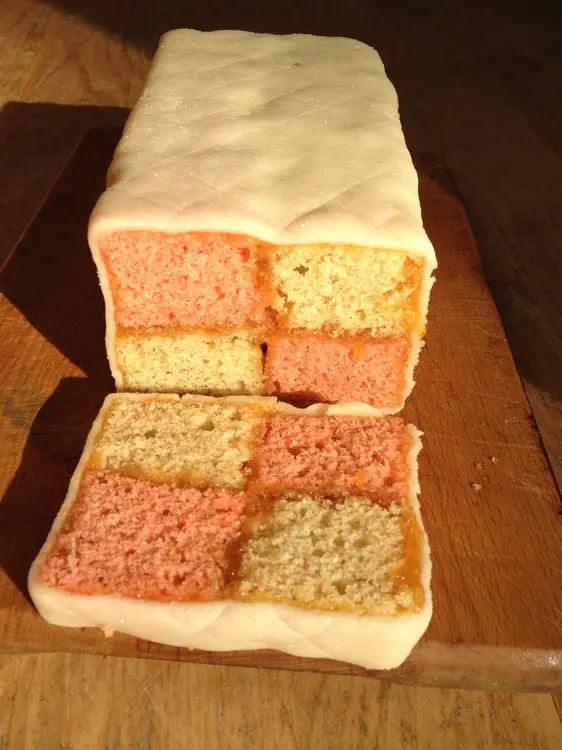
A horizontally dissected cluster house is like Battenberg cake
The best and most original way to describe a cluster house is to compare it with Battenberg cake. If you dissected a cluster house along the horizontal of a block of four properties, and looked at it from an aerial view, it would look like a slice of Battenberg cake.

What is the meaning of cluster house?
Cluster houses have the following characteristics to make them into cluster homes:
- Each property in the cluster is a freehold property. This means the owner (i.e. the freeholder) of the cluster house owns it outright, including the land it’s built on.
- Each property is a landed property. In the context of cluster houses landed means that the owner of the property owns the land beneath it.
- Properties in the cluster share two or more party walls. Cluster houses on the end of the block share two common party walls, whereas cluster houses in the middle of six or more cluster houses share three party walls.*
- The rear wall of a cluster house is a shared party wall. The back wall of cluster houses is shared with the property behind it.
- Cluster houses own their section of the whole roof. Each cluster house is responsible for the section of roof that covers their section of the block.
- Cluster houses are made up of four or more properties in one building. For a cluster house to be a cluster home there has to be four or more properties linked together in a square or oblong shaped building. A house in a block of four cluster houses is also known as a quarter house.
- Cluster houses in blocks of four have their own garden to the side of the house and not to the rear. Cluster houses in blocks of four share their back walls with another property in the block, which means it cannot have a back garden. Instead of a back garden, cluster homes in blocks of four will each have a garden to the side of the house.
- Cluster houses of six or more properties tend to share a communal garden space. Cluster houses in blocks of six or more properties will share outside and garden space as a communal area.
- A cluster house is a residential home: Cluster homes are residential houses built in blocks of four or more houses.
* The number of shared party walls is illustrated in the above image with blue dots to indicate the shared party walls.
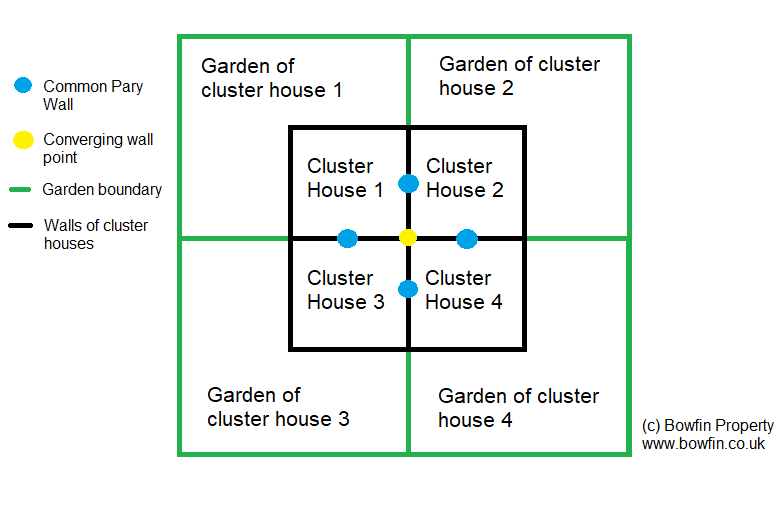
Cluster house examples – building of 4 cluster houses illustration
The above image of cluster houses is an example of four individual properties and illustrates the following characteristics of a cluster house:
- A central convergence of four walls illustrated by the yellow dot.
- Common party walls with each property sharing two party walls with another property in the block, as illustrated by the blue dots.
- The garden configuration of a 4-block of cluster homes illustrates how the garden is to the side of the house, instead of to the rear.
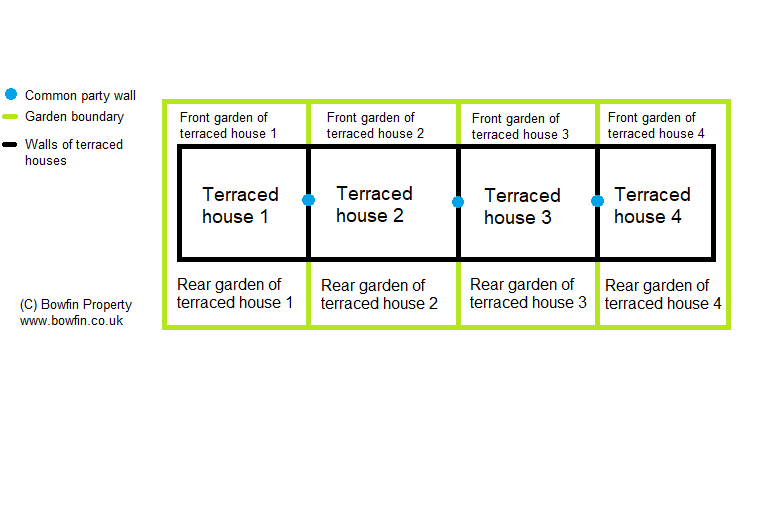
What is the difference between a cluster house and a terraced house?
Terraced houses share one or more party walls with other properties in a terrace and don’t share the back wall with another property. But cluster houses share two or more party walls with other properties in the building and the back wall is a shared party wall with another property in the block.
The above image illustrates a row of four terraced houses and illustrates how the two outside houses, which are known as end of terraced houses, share only one common party wall, as illustrated by the blue dot.
The middle two terraced houses (or mid-terraced houses) share two common party walls, which is similar to a cluster house.
But the difference between these mid-terraced houses and a cluster house is the terraced house shares the walls on either side of the property, which means the back wall is not shared and backs on to the rear garden, which is something a cluster house doesn’t have.

What is the difference between a cluster house and a semi-detached house?
Semi-detached houses share one common party wall with the other property in the building or duplex and don’t share the back wall with another property. But cluster houses share two or more party walls with other properties in the building and the back wall of the property is a shared party wall.
Each cluster house has its own land to the side, which is similar to that of semi-detached houses, but without the garden at the back of the house.
In general, cluster houses are more affordably priced than semi-detached houses.
The above illustration of a semi–detached house, which is often abbreviated to a semi, is a single family duplex dwelling house that shares one common wall with the other property. The common party wall is indicated using a blue dot in the illustration.
This illustration also shows how each semi-detached house has its own front and rear garden, which is different to the illustration of a 4-block of cluster houses above.
Cluster house vs semi detached house
Given the choice of a cluster house vs a semi detached house, the semi-detached house is better for the following reasons:
- Semi-detached houses share only one common party wall vs cluster houses that share two or more common party walls.
- Most semi-detached houses have a front and rear private garden vs cluster houses that only have small side gardens, shared communal gardens or no garden at all.
- Cluster houses can be noisier than semi-detached houses, as they have more common party walls.
Having said that, the reason you may choose a cluster house over a semi-detached house is down to cost, as cluster houses tend to be cheaper than semi-detached houses, with all else being equal.
But also both cluster houses and semi-detached houses are freehold properties, so the owner owns the property outright and the land it sits on
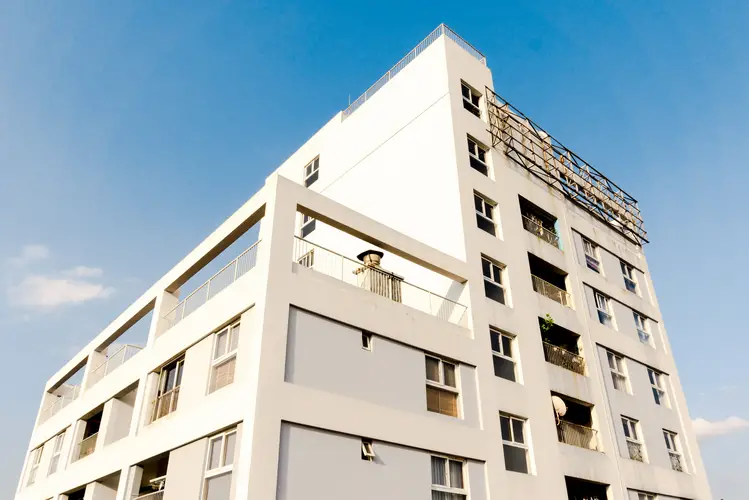
What is the difference between a cluster house and a flat or apartment?
Cluster houses are freehold properties, which means the owner or freeholder of the cluster house owns it outright, including the land it’s built on. Whereas the owner of a flat or apartment doesn’t own it outright, as the property is leasehold and means they don’t own the land beneath it.
The owner of a flat or apartment also do not own the roof of the building, whereas the owner of a cluster house owns the section of roof that covers their part of the overall building.
Owners of flats and apartments contribute to a maintenance fund to pay for the common areas and parts of the building, including the roof and outside structure.
Flats and apartments are similar to cluster houses, as they often share two or more common party walls with another flat or apartment in the building.
What is the difference between a cluster house and a maisonette?
Cluster houses are freehold properties, which means the owner or freeholder of the cluster house owns it outright, including the land it’s built on. Whereas the owner of a maisonette doesn’t own it outright, as the property is leasehold and means they don’t own the land beneath it.
A typical maisonette is a property that is split horizontally, with an upstairs and a downstairs owned by separate people and no common parts internally. The quarter or cluster house is a similar to this, but is split vertically with each person owning a quarter of each storey.
There are service charges with maisonettes vs a cluster house there are not, unless the cluster houses share communal gardens, swimming pools and roads.
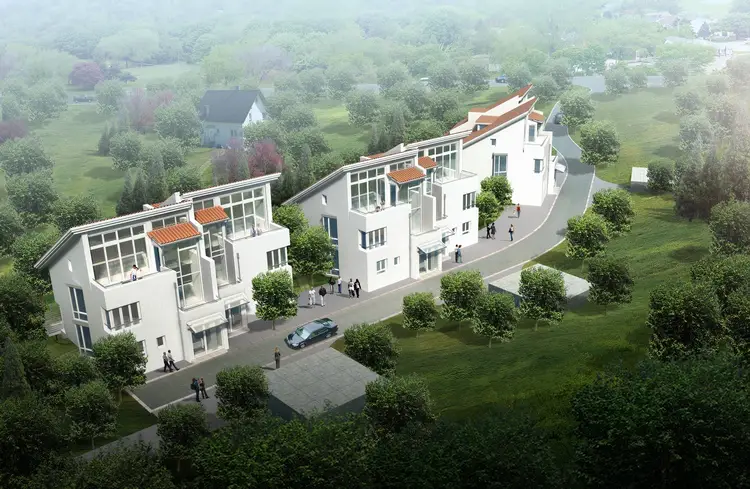
Are cluster houses good?
Cluster houses are good from a pricing perspective and make good starter homes, as they tend to be slightly cheaper than a semi-detached houses of comparable size.
They also make good investment properties, as the rent will be similar to a house of similar size, but the cost of the investment will be lower.
However, cluster homes tend to be similar in price to terraced houses, without the benefit of a back garden, which some buyers may not like.
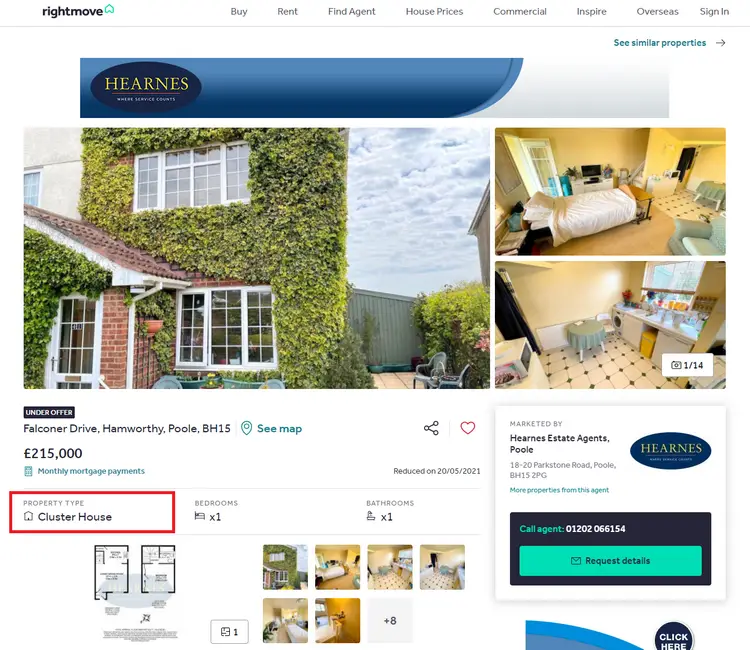
Cluster houses on Rightmove
When you search for houses on Rightmove you cannot make a “property type” selection of “Cluster House“, as this is not a searchable method on Rightmove.
But there are houses classified as cluster houses on Rightmove, as per the above image of a property in Poole in Dorset.

When you come to search for properties on Rightmove in your chosen area, you cannot select “Cluster House” as an option, as per the above image taken from the search function on Rightmove.
The only method I can see to search specifically for cluster houses for sale of Rightmove or similar is to use Google search.
When you search on Google, type in the phrase “Cluster houses for sale in XXXX“. Replace the “XXXX” with the town or city where you are looking to buy a cluster house.
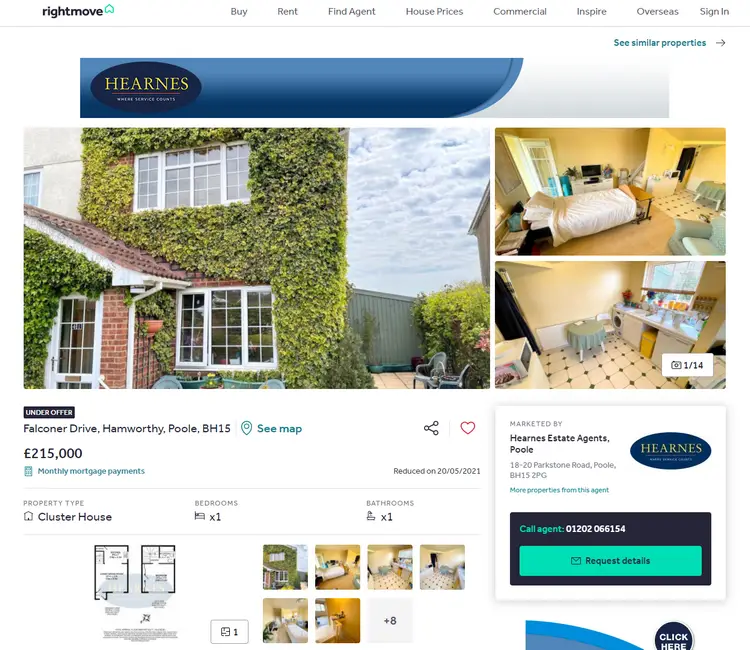
What is a cluster home UK?
A cluster home in the UK is a building of four or more individual properties where each property shares two or more party walls with one of the other properties in the cluster. Cluster homes are freehold properties, which means the owner of property owns it outright including the land it’s built on.
If you look at the “Property Type” on the above image from Rightmove, you’ll see this is an example of a cluster home in the UK. Which in this case is in Poole, Dorset. Another example of cluster homes in the UK is shown below in the red box on the image from Off-Plan.
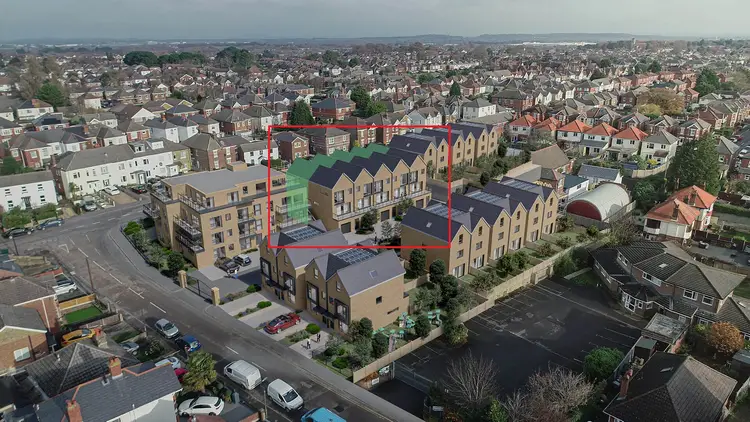
Can cluster homes be bungalows?
Cluster homes can just as easily be a group of four or more bungalows, where each bungalow would share two or more common party walls with another bungalow. Each one will be a freehold property so the owner owns the land it’s stood on and the section of roof that covers their bungalow in the building.
Can you get a mortgage on a cluster house?
You can get mortgages on cluster houses as easily as you can on any other house, as long as the building is of standard construction and is in a mortgageable state of repair.
You can also get a buy to let mortgage on a cluster house as an investment property and let the property to tenants too.
Is cluster housing a good investment?
Cluster houses make good investment properties, as the rent will be similar to a semi-detached house of similar size, but the cost of the investment will be lower, thereby offering a higher return on investment.
Cluster house insurance
The insurance of a cluster house will be similar to a semi-detached house or a terraced house, as the house has common party walls with another property. You will need to disclose the type of property as a cluster house when you complete the insurance questionnaire.
Insurance companies can refer to cluster houses as quasi-semi houses.
Is Cluster House considered landed?
A cluster house can be considered as a landed property, where in this context a landed property is a freehold property where the owner or freeholder of the property owns the land it sits on.
What are the pros and cons of a cluster house?
As with anything, there are always pros and cons to consider. As far as buying a cluster house goes, the pros and cons include:
The pros of a cluster house
- Cheaper to buy: Cluster houses are cheaper to purchase than semi-detached and detached houses.
- Less impact on the environment: Cluster homes use less land to build so there is less of an environmental impact.
- Create local communities: Cluster homes tend to create good local communities.
- More energy efficient: Cluster house only have one or two outside walls so they are more energy efficient and have a reduced energy consumption.
- Reduced construction cost: Due to the design of a cluster building the cost to build cluster houses is cheaper than a terraced house, a semi-detached or a detached house.
- Cluster houses are freehold properties: You own the freehold of a cluster house, which means to own it outright and the land it stands on.
- No upstairs neighbour noise: As the upstairs of cluster houses is part of the same property, there’s no chance of upstairs neighbour noise like you would get in a flat or a maisonette.
- Great for first time buyers as a starter home: Cluster homes tend to be cheaper to buy so make great houses or starter homes for first time buyers as their first freehold property.
The cons of a cluster house
- Can be noisy: Cluster houses are more likely to be nosier than semi-detached or detached houses as they share at least two common parties walls with another house.
- Central cluster houses in blocks of six or more can be even noisier: Cluster houses in the middle of a block of six or more cluster homes share three common parties walls, which could make them even noisier, depending on the insulation and construction of the party walls, and on how noisy the neighbours are.
- No back garden: Cluster houses don’t have back gardens.
- Shared gardens with blocks of six or more cluster houses: Cluster houses in blocks of six or more share gardens, although the cluster house on the end of the building may have their own garden to the side.
- The roof is shared: Properties with shared structures can be problematic in the event of a fall out between neighbours.
- Close neighbours: You cannot afford to fall out with your neighbours as they are in close proximity.
- Some cluster houses don’t have gardens: Some cluster houses don’t have a garden, which may put some buyers off.
- Gardens can be a short walk from the house: A garden that is a walk from the property is less convenient and poses a security problem for garden furniture and the like to be stolen.
- The staircase can take up a large space: As cluster houses tend to be small, the staircase can take up proportionately more space in the house.
- Staircases tend to be off the living room: Some buyers don’t like staircases in the living room, as this takes up space in the room and the heat in the room migrates up the stairs.
- Cost the same as terraced houses: Cluster house tend to be priced similar to terraced houses, despite the fact they don’t have back gardens.
Is a cluster house noisy?
Cluster houses can be noisy as they share at least two common party walls with other properties in the building. Cluster houses in the middle of a block of six or more cluster houses can be even noisier as these share three party walls.
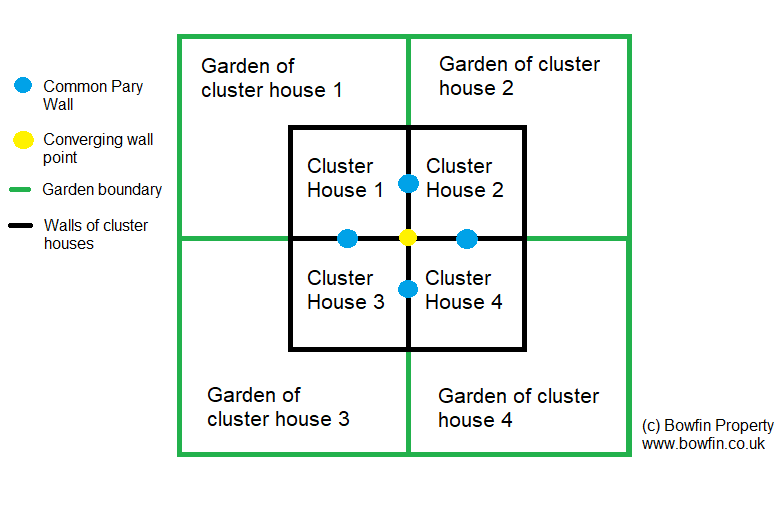
Do cluster houses have gardens
Not all cluster houses have their own gardens, as the garden can be a communal garden that is shared by all the residents in the cluster houses in the block, or the garden can be a short walk from the house. Cluster houses in blocks of four properties tend to have gardens to the side of the house.
Cluster houses that immediately fronts onto a road tend not to have a garden. In this example, the houses at the rear of a block of four cluster houses usually have gardens to the side of each house. The houses that front the road either won’t have gardens or these will be a short walk from the property.
The security for a garden that’s not next to the house will not be as good, which means that garden furniture and the like may be vulnerable to be stolen.
Also, some cluster houses have an all-round communal garden that surrounds the whole building.
Are cluster houses town houses?
Many cluster houses are also town houses as they are built over three stories, which are common in America. But even cluster houses that are configured as town houses share at least two common party walls with two other properties in the cluster building.
Where a cluster house is designed as a town house over three floors, these are often referred to as quad townhouses.
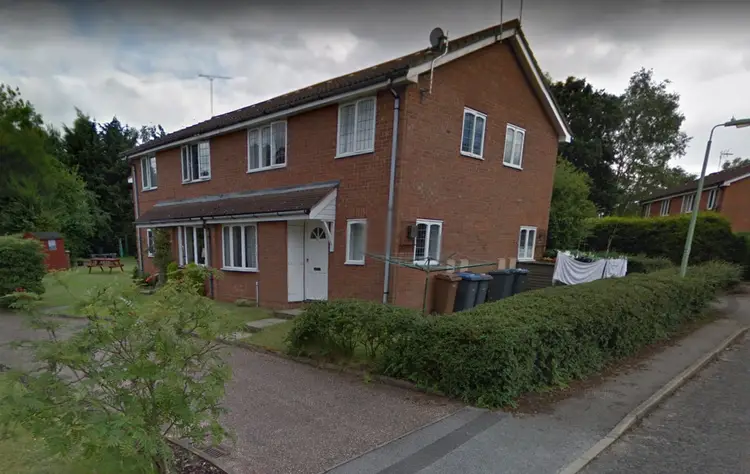
What is a quarter house?
A quarter house, which is also known as a cluster house, is a group of four houses attached to each other in a square building. This is like joining two pairs of semi-detached houses by their back walls. Each quarter house will share two common party walls with another property in the block.
One way to describe quarter houses and cluster houses is as back-to-back semi-detached houses or as a building divided vertically into four quarters, each with its own separate entrance and side garden.
What is a cluster house in South Africa?
A cluster house in South Africa is a freehold property, which means you gain individual title to your property and immediate garden, but you are also entitled to use the communal parts of the overall property, which includes the roads, gardens, swimming pools and security.
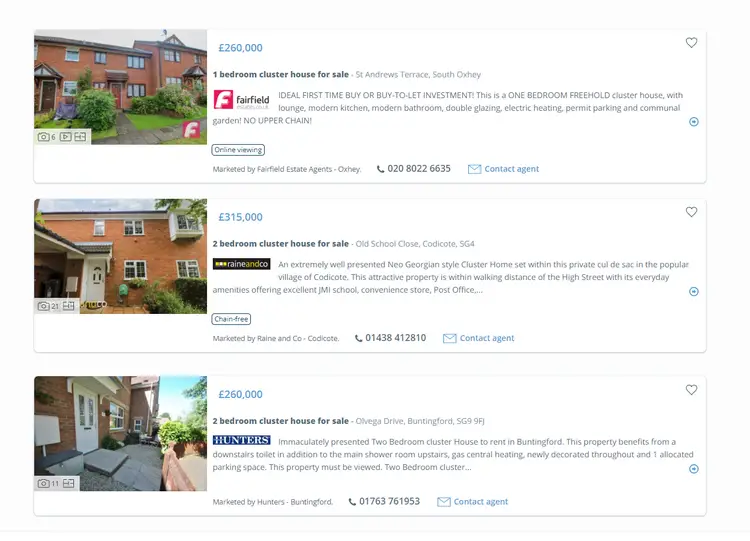
Final thoughts on what are cluster houses
Cluster houses have been around for a long time and have previously been referred to as quarter houses, which you can understand when you look at my comparison to Battenberg cake above.
Another way of describing cluster houses is back-to-back houses, as each property backs on to another property.
Quarter houses were being built as far back as the Victorian times. In fact there are still many of these cluster houses or quarter houses in Leeds that were built in the Victorian times.
In Scotland, cluster houses are sometimes referred to as a quarter-villa or four-in-a-block when they are configured as a block of four properties.
The advantage of a cluster house over a flat or apartment is the cluster house is freehold, whereas a flat is leasehold. This means there will be less restrictions over a cluster house vs the lease restrictions and covenants that tend to apply to blocks of flats.
Cluster houses tend to be in blocks of 4 x 1 bed houses, or 4 x 2 bed houses or 6 x 1 bed houses, or I’ve seen them as 5 x 2 bed houses.
Finally, you may also like to discover how you could save you up to £71,475 when you buy your next house if it would originally cost £350,000. Alternatively, if you propose to buy your next house for £250,000, the saving could be up to £51,852 instead.
To find out more, plus to get hold of my free mortgage savings calculator tool, please take a look at my video course about how to sell your house in under 2 weeks for more money.
Please don’t forget to read this before you leave…
Please don’t forget to also read this article to discover how you could save over £70,000 on your next mortgage if you sell your house and rent before buying again. As I said earlier, even I was amazed when I did the calculations!
I hope you’ve enjoyed this article about what is a cluster house
If you’ve enjoyed this article about what is a cluster house please share it on your favourite social media site.
Also, if you have any questions, please feel free to comment below too. Alternatively, if you need more help, please feel free to contact us on our contact us page here. Or join the discussion and ask your question in the property forum.


